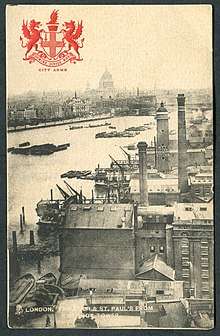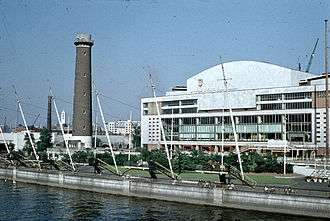Shot Tower, Lambeth
The Shot Tower at the Lambeth Lead Works was a shot tower that stood on the South Bank of the River Thames in London, England, between Waterloo Bridge and Hungerford Bridge, on the site of what is now the Queen Elizabeth Hall. It was a prominent landmark on the river and featured in a number of paintings, including by J. M. W. Turner.

Raphael Tuck & Sons postcard, Series 2174 ″London Heraldic View″

History
The Shot Tower was built for Thomas Maltby & Co. in 1826, designed by David Riddal Roper. In 1839, it was taken over by Walkers, Parker & Co., a company that also operated the square shot tower to the east of Waterloo Bridge. They operated the tower until 1949 and shortly after that it featured near the end of the film Night and the City (1950). In 1950, the gallery chamber at the top of the tower was removed and a steel-framed superstructure was added instead, providing a radio beacon for the 1951 Festival of Britain. It was the only existing building to be retained on the site for the Festival. After the Festival, the tower was demolished to make way for the Queen Elizabeth Hall, which opened in 1967.
Description
The tower was brick-built, with a slight taper. At the base it was 30 feet (9.1 m) in diameter, with 3-foot (0.91 m) thick walls. At the gallery located at the top, it was 20 feet (6.1 m) in diameter with 18-inch (460 mm) walls. The gallery chamber was surrounded by a cornice and parapet, with an iron balustrade. The gallery was 163 feet (50 m) high and was reached by a spiral staircase attached to the inside face of the wall. Halfway up there was a floor for making small lead shot. The gallery level at the top was used for making large shot.